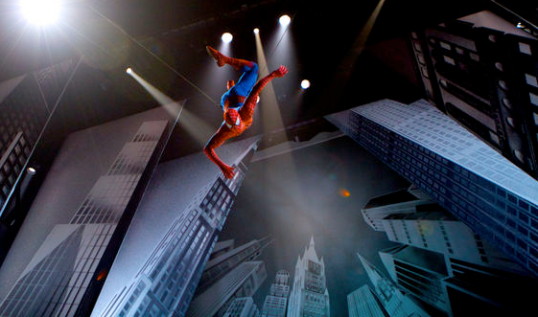In fact, the latter portion feels like another production entirely. The Geek Chorus gets chased from the stage by Arachne’s Furies–who are a crew of women in spider-costumes and headpieces that look like Viking helmets–and a “Spider-Man No More!” moment early in the second act narrows the focus to Peter and MJ doing the why-aren’t-you-there-for-me? dance. A bunch of villains teams up to be the Sinister Six, er, Seven and their global havoc unleashes a blackout on the city that Peter, having cast off his powers, refuses to investigate. Peter shirking Spider-Man duty insults Arachne and she lures him into a showdown where he must choose life as her harried spider-servant or a normal existence in a permanent blackout.
(More on TIME.com: How To Kill A Superhero Franchise In 20 Easy Steps: Spider-Man Edition)
Turn Off the Dark‘s great set design tries to channel the energy of comic-book art and largely succeeds, with lots of moving, rotating pieces and painted skyscraper backgrounds drawn from extreme perspectives. Several fight scenes have the actors pantomiming slo-mo sequences in very entertaining fashion. The weird-ass costumes seen in that Vogue photoshoot and Taymor’s use of puppetry for Spidey rogues like Kraven and the Lizard, along with giant masks for the Kingpin, Hammerhead and Fancy Dan (!) all make the proceedings feel hallucinatory and Ditko-esque. The effects throughout are great, including sharp use of video in the second act. And, the much-ballyhooed wirework is a huge crowd-pleaser. Spider-Man stuntmen swoop over the crowd and, depending on the seats you’re in, might crouch right in front of you. The Goblin, too, flies close enough to touch. The gasps and laughs were audible during much of the first act. Still, I feel like I have to issue a few caveats for anyone thinking about bringing kids to Turn Off the Dark. The show gets downright macabre at times, with an early scene depicting Arachne’s suicide and other sequences might produce nightmares in sensitive younger children. Don’t go into this expecting a worry-free, popcorn entertainment.
Lots of other developments happen in the play that will get eyes rolling, too. Secret identities get dispensed with willy-nilly, Aunt May hardly figures into the proceedings at all and Peter blurts out an anxiety-driven marriage proposal. That’s to say nothing of the non-ending that left me asking, “Wait, what?”
(More on TIME.com: Why The Spider-Man Movie Reboot Will Be Awesome)
It’s clear that Taymor and her collaborators dug into the source material. The technical aspects of the show shine very brightly and testify to the great care taken to channel the fun and energy of Spider-Man into a new kind of venue. Peter’s angst about superheroing dovetails into a subtext about fate, free will and the reluctance to take on responsibility, all themes that classic myth deals with, too. Those aspirations aside, even if you brush off the fanboy complaints, the core thematic architecture of Turn Off the Dark just doesn’t hold together. The show’s essentially a weird triangle between Peter, MJ and Arachne. An odd, psychosexual dream sequence with Peter and Arachne gestures at representing the dysfunctional relationship Spider-Man has with what makes him who he is. But, whether it’s that scene or the pivotal one where Peter and Arachne have it out over his destiny, it’s all too muddled. It’s never clear what Arachne really wants. Audiences might forget the thematic jumble if there were a big, pyrotechnic finish but the wirework practically disappears from the second half. And, if the musical’s meant to a new Spidey fable, it’s one without a clearly discernable moral. There’s lots of ambition and great execution inside of it but, ultimately, Spider-Man: Turn Off the Dark stretches the webbing of the lead character’s mythos so far that it breaks.
(More on Time.com: Andrew Garfield On Spider-Man: I’ve Been Preparing Since I Was Four)


